Managing litchi orchards for maximum productivity can be a challenging task. However, by adopting a month-wise approach, orchard owners can simplify the process and achieve successful operations. This guide serves as a comprehensive roadmap, providing valuable insights and strategies tailored to each stage of the litchi tree’s growth.
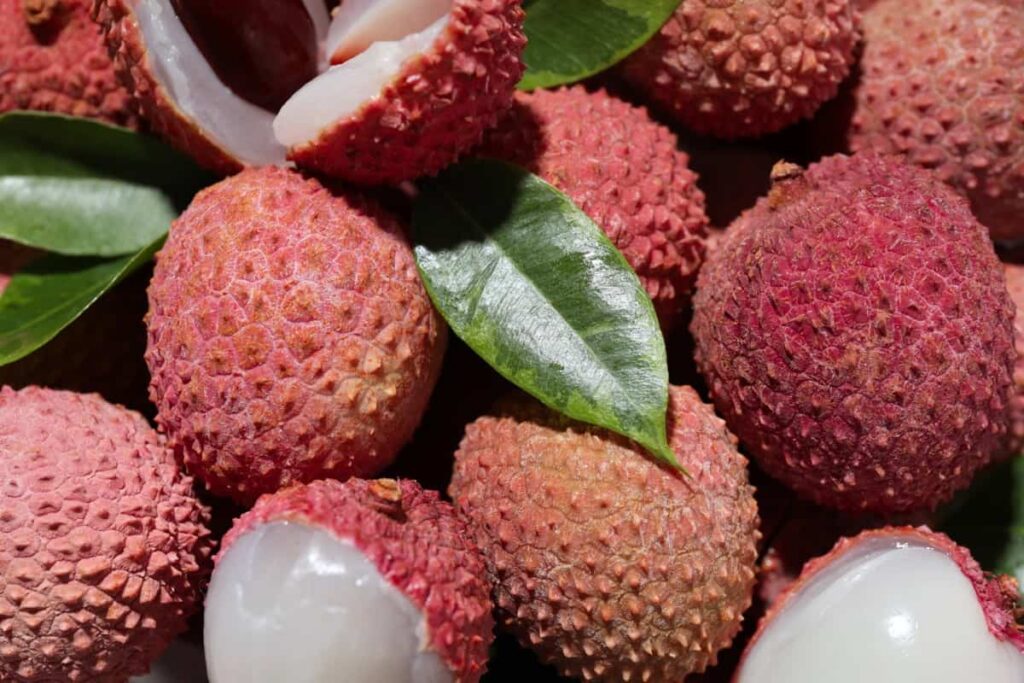
Following the month-wise plan, orchard managers can make informed decisions and implement effective practices to enhance productivity and fruit quality. This ultimately leads to increased profitability. Whether you’re a seasoned orchard owner or just starting, this guide will equip you with the knowledge and tools to optimize your litchi orchard operations throughout the year.
Litchi Orchard Management
What is Litchi Farming and its Overview?
Litchi, scientifically known as Litchi chinensis, is a unique and tropical fruit tree belonging to the soapberry family, Sapindaceae. It originates from South China and has been widely cultivated throughout Southeast and South Asia. Litchi farming has a rich history, dating back to the 11th century in China. This tall evergreen tree produces small, fleshy, and delectably sweet fruits. The fruit’s outer shell is rough-textured, pink-red, and easily peels away.
Litchi seeds contain methylene cyclopropyl glycine, which, when consumed in large quantities by malnourished children, has been associated with hypoglycemia-related encephalopathy. Litchi chinensis is an evergreen tree with pinnate leaves of 4 to 8 elliptic-oblong to lanceolate leaflets. The bark is gray-black, and the branches have a brownish-red hue.
The tree blooms with terminal inflorescences, bearing panicles of fragrant white, yellow, or green flowers. Depending on various factors, the litchi fruit takes approximately 80 to 112 days to mature. It comes in different shapes, ranging from round to ovoid to heart-shaped, and measures up to 5 cm long and 4 cm wide. The thin, tough skin transforms from green to red or pink-red as it ripens.
Peeling reveals a layer of translucent white fleshy aril with a sweet flavor and a pleasant floral aroma. The fruit contains a single inedible dark brown seed that varies in size. Litchi fruits are commonly consumed fresh due to their delicate floral flavor, which is lost during the canning process. Some cultivars yield fruits with shriveled seeds, known as ‘chicken tongues,’ which often have a higher market value as they provide more edible flesh.
In case you missed it: Optimizing Avocado Orchard Management: A Month-by-Month Maintenance Guide for Maximum Yield
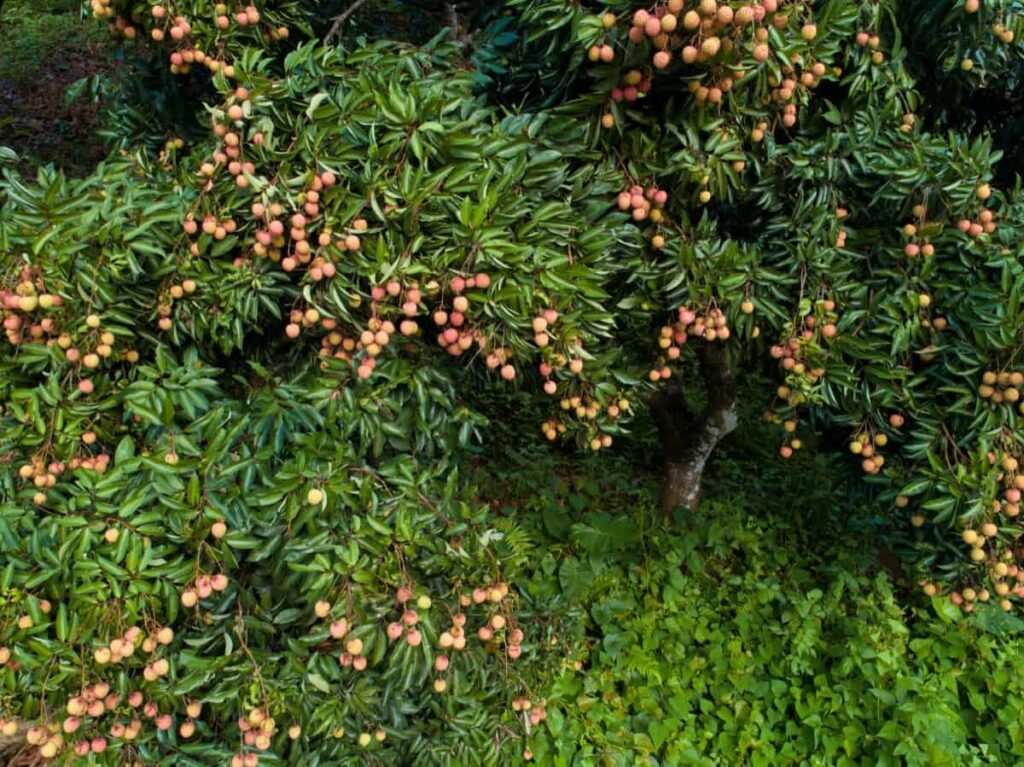
Importance of Month-Wise Planning for Litchi Orchard Maintenance
Month-wise planning for litchi orchard maintenance is crucial as it aligns with the specific needs of the trees at different stages of growth, optimizing tasks such as pruning, irrigation, fertilization, pest control, and harvesting for maximum productivity and fruit quality.
Best Tips for Growing Litchi Orchard Maintenance Practices
- Climate: Litchi thrives in a temperature range of 25-35°C. It requires a rainfall of around 1200mm for proper growth. The sowing temperature should be 25-35°C, while harvesting is ideal at 25-30°C.
- Soil: Litchi can be grown in various soils, but it prefers deep, fertile, well-drained soil with a pH of 7.5 to 8. Avoid high pH and saline soils as litchi cannot tolerate them.
- Popular Varieties: Some popular litchi varieties include Calcutta, Dehradun, Seedless Late, Rose Scented, Saharanpur, Muzaffarpur, Khatti, and Gulabi. Each variety has characteristics such as fruit size, flavor, and maturity time.
- Land Preparation: Plough the land, perform cross-plowing, and level it to prevent water stagnation. Proper drainage is essential for litchi cultivation.
- Sowing: Plant litchi seedlings in pits measuring 1m x 1m x 1m. Fill the pit with topsoil, well-decomposed cow dung, bone meal, and MOP (Muriate of Potash). Transplant two-year-old plants or opt for direct sowing.
- Propagation: Litchi is primarily propagated through air-layering. Select pest- and disease-free branches for air-layering and plant them in nurseries.
- Pruning and Training: Train young litchi trees to give them a definite shape. Light pruning after fruit harvest promotes new shoot growth.
- Intercrops: Intercropping can be practiced for 3-4 years to maximize land utilization. Suitable intercrops include peach, plum, kinnow, vegetables, and pulses. Remove intercrops when the orchard enters commercial bearing.
- Irrigation: Provide irrigation at all stages of development. Young plants require frequent irrigation, while older plants can be watered once a week during summer. Apply irrigation twice a week during fruit development to minimize fruit cracking.
- Plant Protection: Protect young plants from hot winds and cold waves by planting windbreak trees and growing Dhaincha around the plantation. Take preventive measures against pests like fruit borers, mites, leaf miners and diseases like downy mildew, anthracnose, root rot, red rust, and fruit rot.
- Fertilizer: Apply well-decomposed cow dung, urea, SSP (Single Super Phosphate), and MOP (Muriate of Potash) based on the age of the crop. Adjust the fertilizer quantities accordingly.
In case you missed it: Mastering the Dragon Fruit Orchard Management: A Month-by-Month Operations Guide for Maximum Yield
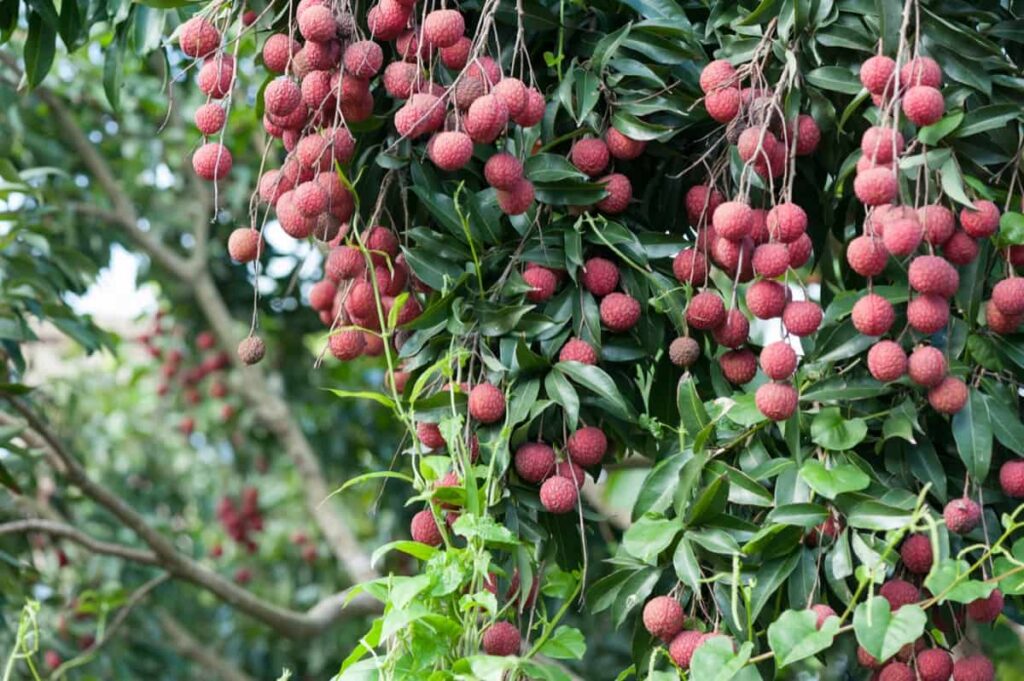
- The months of August to September, right after the monsoon season. This allows the young plants to establish their roots before winter. In some regions like Punjab, planting can be extended up to November.
- Following proper spacing guidelines is important when sowing litchi seeds or transplanting seedlings. Maintain a distance of 8-10 meters between rows and individual plants if using the square planting method.
- Dig pits of 1m x 1m x 1m and expose the soil to the sun for a few days. Fill the pits with topsoil mixed with well-decomposed cow dung, bone meal, and MOP (muriate of potash). Sprinkle some water after planting the seedlings in the middle of the pit.
- Litchi trees can be propagated through air-layering, the preferred commercial method. Select 2-3cm in diameter and 30-60cm long branches, free from pests and diseases. Remove a 4cm wide bark ring with a sharp knife, place wet moss on the exposed area, and tightly wrap it with a polythene sheet.
- After about four weeks, when many roots have developed, detach the air-layered portion from the mother tree and immediately plant it in a nursery. Provide irrigation to the newly planted air-layered trees.
- Pruning and training are essential for shaping litchi trees initially, but excessive pruning is optional. Light pruning after fruit harvesting helps promote new shoot growth.
- During the initial 3-4 years, intercropping can be practiced when the orchard is still in its slow growth phase. This provides additional income, enriches the soil, and helps control weeds. Quick-growing plants like peach, plum, kinnow, and certain vegetables and pulses can be intercropped. However, once the orchard reaches commercial bearing, it’s advised to uproot the intercrops.
- Since litchi is cross-pollinated, pollination is done by insects and honey bees. Placing 20-25 boxes of honey bees per hectare ensures proper pollination and fruit set.
- To protect young litchi crops from hot winds in summer and cold waves in winter, it’s recommended to plant suitable windbreak trees around the plantation. Growing Dhaincha around the litchi plantation protects during both seasons. Tall tree seedlings such as Mango and Jamun can also be planted around the litchi plantation to shield it from heavy winds.
- Appropriate irrigation is crucial at all stages of development. Young plants require frequent irrigation, especially in summer, while older plants need irrigation once or twice a week.
- Watering should be done after completing the fertilizer application. Water should be applied for frost protection at the end of November or early December. During fruit development, irrigation twice a week helps reduce fruit cracking.
- Litchi orchards are prone to various pests and diseases. Fruit borers can damage fruits, while mites and leaf miners affect the leaves. Proper pest control measures such as releasing Trichogramma, using insecticides like Nimbicidine and Dichlorvos, and pruning affected portions can help manage these pests.
- Diseases like Downy Mildew, Anthracnose, Tree decline and Root Rot, Red Rust, and Fruit Rot can also occur. Preventive measures like maintaining cleanliness, spraying appropriate fungicides, pruning operations, and providing proper drainage help prevent and manage these diseases.
- Harvesting litchi is determined by the change in fruit color from green to pink and the skin’s smoothness. Harvesting is done in bunches, including a small portion of leaves and branches. Litchi fruits have a poor shelf life and should be harvested and stored at the right maturity stage for the best quality.
In case you missed it: Optimizing Indian Jujube/Ber Orchard Management: A Month-By-Month Operations Guide for Maximum Yield
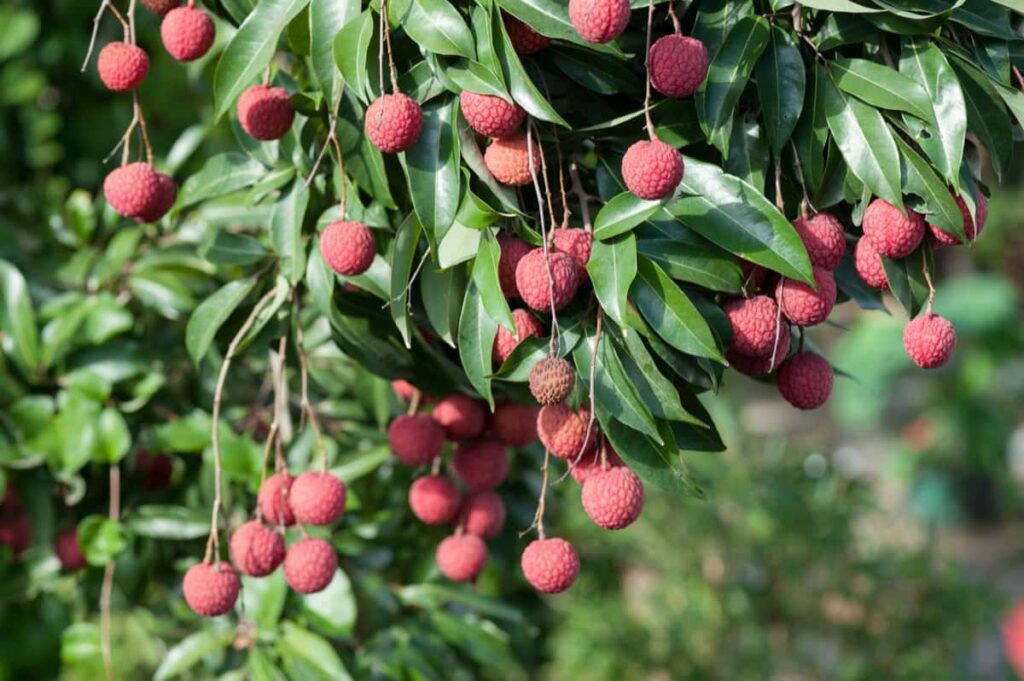
January Month Litchi Orchard Maintenance Planning
Plant Protection: Take preventive measures to protect litchi crops from pests and diseases.
- Release Trichogramma for pest control.
- Use insecticides like Nimbicidine and Dichlorvos and prune affected portions.
- Maintain cleanliness, spray appropriate fungicides, and ensure proper drainage to manage diseases.
- During January, focus on pruning and training young trees to shape their growth.
- Remove any dead or diseased branches to maintain optimal tree health.
February Month Litchi Orchard Maintenance Planning
Windbreak and Shelter Plantation: Plant windbreak trees such as Dhaincha, Mango, and Jamun around the litchi plantation to shield it from hot winds in summer and cold waves in winter.
March Month Litchi Orchard Maintenance Planning
Pollination: Since litchi is cross-pollinated, ensure proper pollination by placing 20-25 boxes of honey bees per hectare. This helps in fruit set and enhances the yield. As the temperature rises, protecting litchi trees from excessive heat and sunlight becomes crucial. Install shade nets or use mulch around the base of the trees to regulate temperature and conserve soil moisture.
April Month Litchi Orchard Maintenance Planning
Fertilization: Apply well-decomposed cow dung, urea, SSP (Single Super Phosphate), and MOP (Muriate of Potash) based on the age of the crop. Adjust the fertilizer quantities as required. July requires increased attention as the litchi fruit matures to ensure a high-quality yield. Monitor fruit development regularly and adjust irrigation and fertilization accordingly. Thin out excessive fruit clusters to prevent crowding, which can result in smaller-sized fruits. Implement bagging techniques to protect the fruit from pests and sunburn.
May Month Litchi Orchard Maintenance Planning
Harvesting: Harvest litchi fruits when their color changes from green to pink and the skin becomes smooth. Harvest in bunches, including a small portion of leaves and branches, and handle the fruits carefully due to their poor shelf life.
June Month Litchi Orchard Maintenance Planning
Maintenance and Pruning: Conduct regular maintenance activities such as weeding, mulching, and supporting young plants if needed. Continue with a light pruning to maintain the desired shape of the litchi trees.
July Month Litchi Orchard Maintenance Planning
- Monitor the orchard for signs of diseases like Downy Mildew, Anthracnose, Tree decline and Root Rot, Red Rust, and Fruit Rot.
- Take preventive measures such as maintaining cleanliness, spraying appropriate fungicides, and implementing pruning operations as required.
- Watch for pests like fruit borers, mites, and leaf miners, and use suitable insecticides to control their population.
In case you missed it: Optimizing Date Palm Orchard Management: A Month-by-Month Operations Guide for Maximum Yield

August Month Litchi Orchard Maintenance Planning
- Planting: August is an ideal time for litchi plantation, just after the monsoon season. Young plants can establish their roots before winter. In some regions, planting can be extended up to November.
- Spacing and Pit Preparation: Maintain a spacing of 8-10 meters between rows and individual plants. Dig pits of 1m x 1m x 1m, expose soil to the sun for a few days, and fill them with a mixture of topsoil, well-decomposed cow dung, bone meal, and MOP. Sprinkle water after planting the seedlings.
September Month Litchi Orchard Maintenance Planning
Air-layering: Propagate litchi trees through air-layering.
- Select branches of 2-3cm in diameter and 30-60cm in length, free from pests and diseases.
- Create an air layer by removing a 4cm wide bark ring, placing wet moss, and wrapping it tightly with a polythene sheet.
- After about four weeks, detach the air-layered portion and plant it in a nursery.
October Month Litchi Orchard Maintenance Planning
Pruning and Training: Prune young litchi trees to shape them. Light pruning after fruit harvest stimulates new shoot growth and maintains the desired form.
November Month Litchi Orchard Maintenance Planning
Intercropping: During the slow growth phase of the orchard (initial 3-4 years), practice intercropping with quick-growing plants like peach, plum, kinnow, vegetables, and pulses. Intercrops provide additional income, enrich the soil, and control weeds. However, uproot the intercrops once the orchard reaches commercial bearing.
December Month Litchi Orchard Maintenance Planning
Irrigation: Provide adequate irrigation to litchi plants. Young plants require frequent watering, especially during summer, while older plants can be watered once or twice a week. Watering should be done after completing the fertilizer application. Also, apply water at the end of November or early December for frost protection.
In case you missed it: Optimizing Fig/Anjeer Orchard Management: A Month-by-Month Operation Guide for Maximum Yield
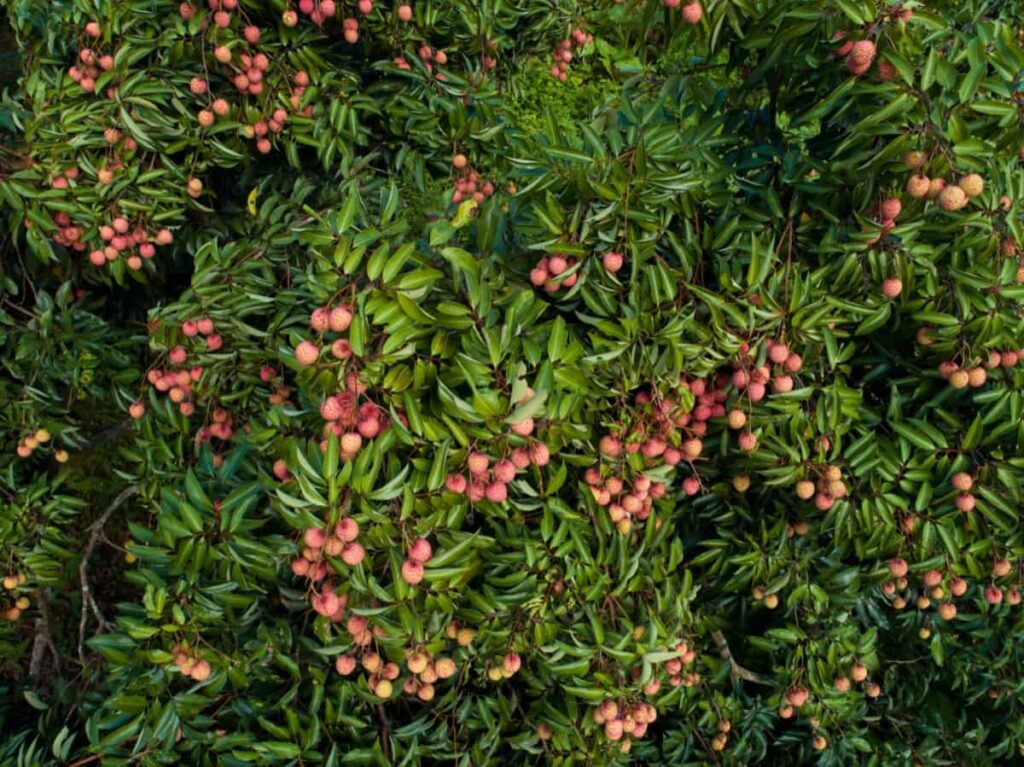
Conclusion
Following a month-wise guide for litchi orchard operations, orchard owners can maximize productivity and optimize their overall success. Each month, from pruning to harvest, presents valuable opportunities to enhance operations and achieve fruitful results.
- Crops Grown in Summer Season: Best Choices for Summer Gardening
- Organic Pest Control for Tomato Farming
- How to Maximize Sheep Farming Profit
- Broccoli Varieties: Choosing the Right Cultivars for Your Farm
- How to Raise Pigs in Your Own Backyard: A Comprehensive Guide
- Budget Friendly Sheep Shed Ideas: Cheap and Low-Cost Tips
- How Much Do Cattle Farmers Make: Revenue Streams in Cattle Farming
- Management Pests and Diseases in Your Cotton Field
- Sheep Farming Business Plan for Beginners
- Aquaponic Farming at Home: A Step-By-Step Guide
- Profitable Village Farming Business Ideas in 2024
- High-Yield Aquaculture: Fast-Growing Fish for Farming
- Effective Fish Pond Construction Techniques for Beginners
- Irrigation and Water Management in Pineapple Farming
- Blossom to Harvest: Mastering Flowering and Pollination in Papaya Farming
- Pig Fattening Essentials: From Selection to Sale for Beginners
- Raising Wagyu Cattle: A Complete Guide for Premium Beef Production
- Soil Types and Their Water Holding Capacity
- Optimizing Irrigation Schedules for Coconut Groves for Enhanced Yield
- Espresso Your Garden: Coffee Grounds for Healthier Acid-Loving Plants
- The Best Soil Mix for Snake Plants: How to Mix Your Own Snake Plant Soil
- Green Thumb Success: Expert Tips for Cultivating Greenhouse Beans All Year Round
- Bloom All Year Round: The Ultimate Guide to Indoor Hyacinth Care
- Eco-Friendly Gardening: How to Make Liquid Fertilizer from Kitchen Waste
- Ultimate Guide to Grow Anise in Pots: Explore Seed Propagation to Harvesting
- Guide to Raising Chester White Pigs: Discover Breed Facts to Growth Management
- Mastering the Elegance: The Ultimate Guide to Weeping Cherry Tree Care, Planting, and Maintenance
- Ultimate Guide to Planting Garlic in Grow Bags: Growing Strategies for Beginners
- How to Fix Spider Plant Leaf-Related Problems: Natural and Organic Remedies
- 10 Reasons Why Your Tulsi Plant is Shedding Leaves: Home Remedies and Solutions
- Optimizing Growth and Yield: The Advantages of Palm Bunch Ash Fertilizer
- Utilizing Neem Oil Extract as a Natural Pesticide for Hydrangea
- From Soil to Harvest: Various Ways in Which Farmers Can Use AI Tools
- Steps to Encourage and Induce Citrus Flowers: A Comprehensive Guide
- How to Fix Snake Plant Leaf-Related Issues: Natural and Organic Remedies
- Transform Your Garden into a Fragrant Oasis with Raat Ki Rani (Night Blooming Jasmine)
